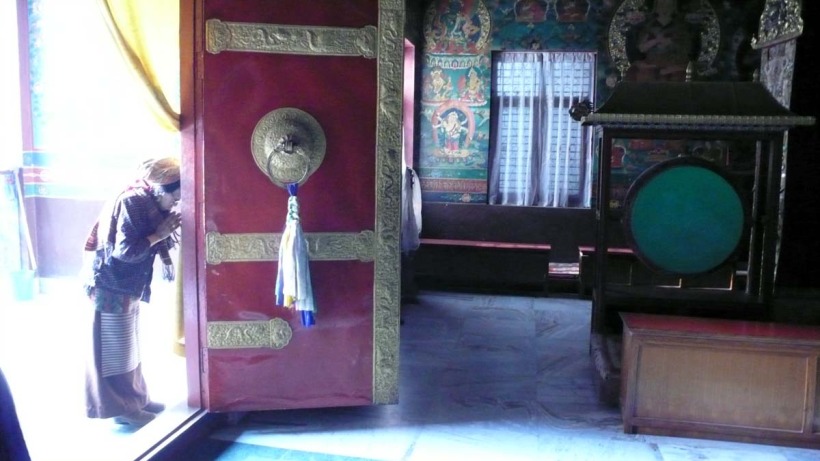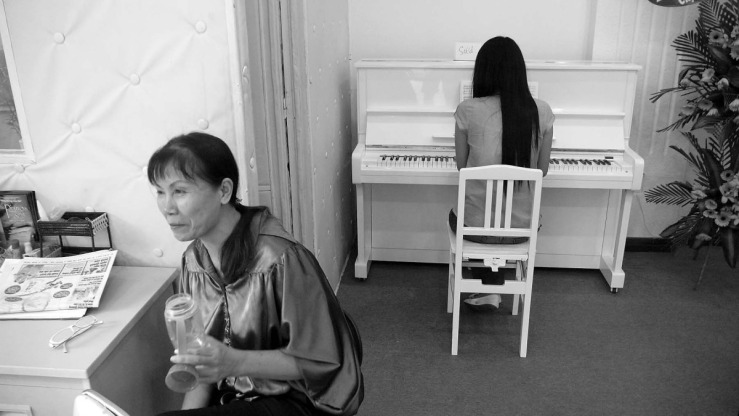Memory Spoke
 05.14.2021
05.14.2021 “I’d rather be a tiger for one day than a sheep for 1,000 years,” chanted a Tibetan monk in a small chapel near the Jokhang Temple in Lhasa.
He sat on a platform swathed in burgundy robes holding the Vajra diamond thunderbolt and bell in his left hand. Ringing the bell he chanted sutras in muted tones.
Pilgrims entered the room through a worn door hanging after spinning copper prayer wheels in a narrow alley and climbing slick stone steps.
Three tall ornate, copper-plated Buddha’s faced them. Past, Present and Future Buddhas contemplated rows of flickering yak butter lamps, fruit offerings, khata scarves, coins and paper money.
Two wooden benches were against a wall. On the floor was a pan of round gray clay balls. Devotees rubbed one on faces and hands before joining others waiting to be blessed. Gathered with bowed heads at the chanting monk’s feet were playful, devout jostling travelers.
He cycled through sutras chanting and touching people on their head with the thunderbolt and pouring holy water on them saying Long Life. They eased away as others moved forward.
He was in a trance state.
An old woman with sky blue turquoise stones woven into her long plaited black hair and wearing a long heavy sheepskin coat sat down next to me. Sharing smiles she mumbled, “Namaste. Blessings to you.”
Whispering ‘Om Mani Padme Hum,’ she fingered prayer beads.
Babbling tongues sang. The bell rang.

Nepal
Awake, I returned to Spanish crypts with my camera. I imaged interments of chiseled names and pueblo connection. Invisible stories dreamed in occupied or empty crypts. They illuminated desire, conflict, ambiguities, metaphors, and silence.
Dreams floated to the listening faithful. They were silent stories of the pious as silent breathing revealed stories inside stories.
“The rest is silence,” said Shakespeare.
The widow observed crouched shadows in rocky fields shifting stones and pruning dead growth from olive trees along the Rio.
Wild yellow and purple flowers blanketed cleared land.
Romans built stone homes and designed baths near the river. They made walled fortifications with defensive mountains behind them. Ten-foot wide dolomite roads twisted from the pueblo down through the valley and beyond for future legions expanding their empire. Soldiers marching west branched north to Seville or south to Cadiz.
Grazalema men loaded cork on tired tractors. Using bedsprings for gates they built pens for sheep, chickens, dogs, goats, and children. Twisted rusting bed coils lay scattered. They used everything trying to tame poor rocky land.
Men assembled fences using blackberry brambles with sharp thorns. They reinforced fences with sticks, recycled old tires, tin cans, metal struts, old cars, and discarded cooking stoves. Chipped bathtubs became watering troughs for livestock. Small stone dams diverted Rio streams to small fields.
Everything was done by hand. Labor worked dawn to dusk, day in day out. Labor cleared erosion’s debris by marking land with tools and footprints.
The widow’s husband slept in the Catholic crypt. Dusty light danced through palm leaves.
She was a full silent moon above his bone white memory. Her spirit danced with spirits.
Spirits treasured clear impermanent memories. Finished sacrificial rituals his cloud vapor danced free from the cemetario to manifest with the full moon above stone fields, yellow flowers and flowing river where men worked their trust.
ART - A Memoir
Adventure, Risk, Transformation

Vietnam






Reader Comments